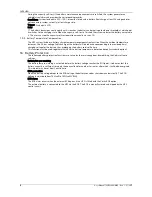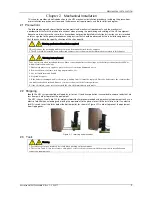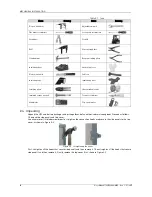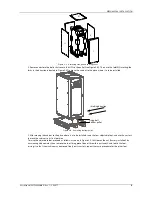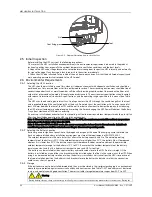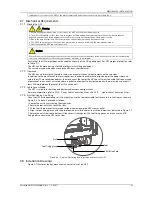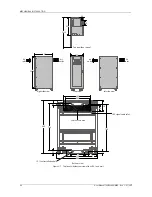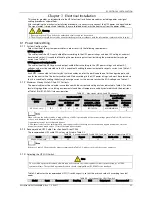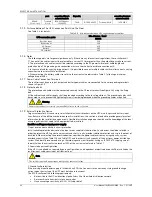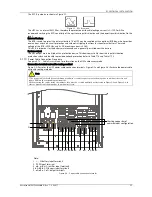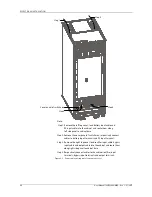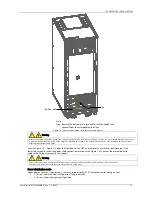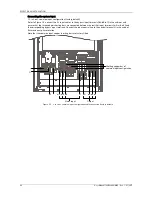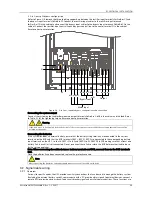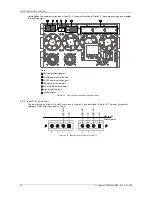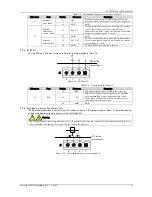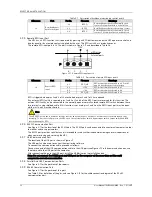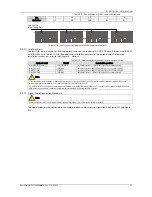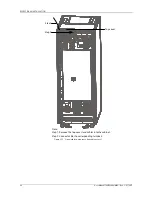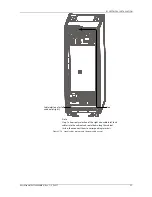
20
User Manual 10H52246UM60 - Rev. 1 - 01/2017
MECHANICAL INSTALLATION
Nut
Foot fixing piece
Foot
Figure 2-5
Diagram illustrating how to raise the feet
2.5
Initial Inspection
Before installing the UPS, carry out the following inspections:
1. Ensure that the UPS installation environment meets the environmental requirements indicated in the product
technical specifications, especially the ambient temperature, ventilation conditions and the dust levels.
2. Unpack the UPS under the guidance of an authorized service engineer. Inspect the UPS internally and externally
for signs of damage. If any damage is found, report it to the carrier immediately.
3. Check the UPS label attached to the inside of the unit front door, and confirm that the data (model, capacity and
main operating parameters) correspond to the UPS model.
2.6
Environmental Requirements
2.6.1
Selecting the UPS Location
The UPS should be installed in a cool, dry, clean-air indoor environment with adequate ventilation, and should be
positioned on a flat concrete floor or similar nonflammable surface. The surrounding environment should be free of
conductive powder (such as metallic powder, sulfide, sulfur dioxide, graphite, carbon fiber, conductive fiber, etc.),
acid mist or other conductive media (strongly ionized substances). The environment specifications should comply
with relevant international standards & specifications, and the operating range specified in this manual (see Table
11-2).
The UPS uses forced cooling by internal fans. Cooling air enters the UPS through the ventilation grills at the front
and is expelled through the ventilation grills at the back. Do not obstruct the ventilation grills. Leave a space of at
least 200 mm between the rear of the UPS and the wall in order to allow heat to dissipate properly, thus reducing
the UPS internal temperature and prolonging its working life. For exchanging the UPS Power Module or the Battery
Tray a front clearance of 1200mm is necessary.
If necessary, install indoor extractor fans to aid cooling-air flow in order to avoid local temperature buildup. Install air
filters (optional) when operating the UPS in a dirty environment.
Note 1: When the battery cabinet is installed near the UPS, the maximum permissible ambient temperature
depends on the battery rather than the UPS.
Note 2: When the UPS is in ECO mode, the power consumption is less than in Normal mode. Suitable air
conditioning systems shall be selected according to the normal operating mode.
2.6.2
Selecting the Battery Location
Batteries generate significant quantities of hydrogen and oxygen at the end of the charging cycle, therefore the
fresh air volume of the battery installation environment must meet the requirements of EN50272-2001.
The ambient temperature is the main factor that affects the battery capacity and life. The normal operating
temperature of the battery is 20°C. If the ambient temperature is higher than 20°C, the battery life will be reduced,
whereas if it is lower than 20°C, the battery capacity will be reduced. Under normal conditions, the permissible
ambient temperature range for the battery is 15°C to 25°C. Ensure that the ambient temperature of the battery
remains constant and that it is kept away from heat sources and UPS air outlets.
The battery can be installed inside a special battery cabinet located close to the UPS. Due to its weight, if the
battery is installed on a raised floor, the bracket must be installed under the floor, in the same way as the UPS. When
using a rack-mounted battery solution, or when the battery is installed at a distance from the UPS, irrespective of
the type of solution, position the battery circuit breaker close to the battery, and make sure that the connection
cables are as short as possible.
2.6.3
Storage
If the batteries are not to be installed immediately, they must be stored in their original packaging in an environment
where they are protected against excessive humidity and heat sources (see Table 11-2). The battery must be stored
in a dry and cool place with good ventilation. The most suitable storage temperature ranges from 20°C to 25°C.
Warning
During battery storage, charge the battery periodically in accordance with the battery manufacturer's instructions. During the











